#Pod Point Charger Installation
Explore tagged Tumblr posts
Text
How to Minimize EV Home Charger Installation Expenses?
As the world shifts towards electric vehicles (EVs), home charger installation has become a key consideration for EV owners. While the benefits of EVs are undeniable, the cost of installing a home charging unit can sometimes raise concerns. This article aims to explore strategies to minimize EV home charger installation home expenses without compromising on quality and safety.
Understanding Installation Costs
The cost of EV home charger installation home can vary based on several factors. These include the location of your electrical panel, the distance between your panel, the charging location, and the overall complexity of the installation process. While the initial expenses might seem daunting, the long-term savings from reduced fuel costs and a lower carbon footprint often outweigh the upfront investment.
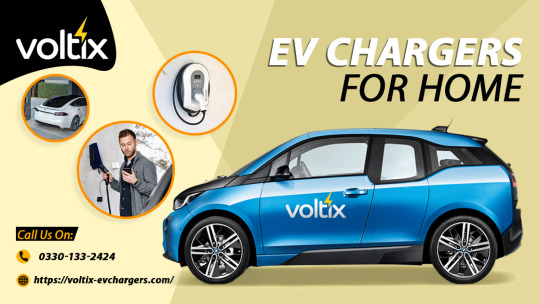
Cutting Down Installation Costs: Key Things To Consider
When thinking of installing an EV charger at home, understanding how to make strategic choices can make the way to a budget-friendly process much clearer. Here are a few things to keep in mind to ensure this: -
Choose the Right Location: Selecting an installation location that is close to your electrical panel can significantly reduce installation costs. A shorter distance means less wiring and labor, translating to a lower overall expense.
Smart Planning: A vital aspect of cost reduction is smart planning. Before installation, consider factors like cable routing and whether any additional electrical work is required.
Opt for Expert Installation: Employing experienced professionals ensures that the installation is done efficiently and accurately. Their expertise can help avoid costly mistakes down the line.
Utilize PME Detection: PME (Pen fault) detection technology can save you money by eliminating the need for an earth rod during installation. This reduces both material and labor costs.
Andersen Car Charger Installation: Your Cost-Effective Solution
When it comes to a reliable and cost-effective EV home charger installation home, look no further than Voltix. As a local family-run business, Voltix is committed to providing excellent customer service and top-notch installation quality. Approved by manufacturers to install any EV charger available on the market today, Voltix ensures that your installation is in capable hands.
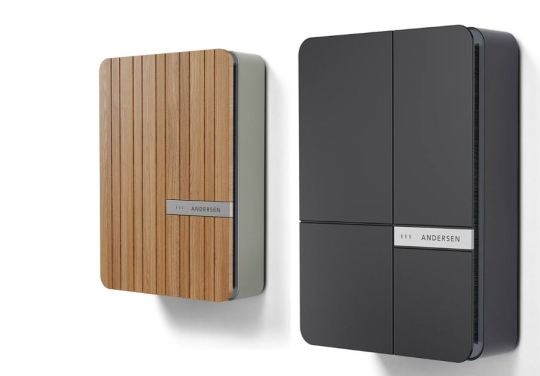
One of the standout offerings from Voltix is the Andersen A2 EV charger installation. This charger enhances the charging experience for electric vehicle enthusiasts with features like an optional 8.5m cable length, 22kW power, and SMART-controlled connectivity. The Andersen A2 not only delivers gorgeous aesthetics but also showcases pioneering technology.
A noteworthy feature of the Andersen A2 is its fully integrated fault protection, making it one of the safest chargers available. Additionally, the PME (Pen fault) detection technology reduces installation costs, allowing you to allocate more of your budget toward the charger itself.
Conclusion Minimizing EV home charger installation home expenses is a concern for many prospective EV owners. However, with strategic planning, the right location choice, and the utilization of advanced technologies like PME detection, the cost can be significantly reduced. Voltix's expertise and their Andersen A2 EV charger installation provide a seamless solution that's not only cost-effective but also ensures safety and quality. By making smart choices during the installation process, you can enjoy the benefits of electric vehicle ownership without breaking the bank.
#Ev Charger Installation#Best Home Ev Charger Installers#Ev Home Charger Installation Home#Andersen Car Charger Installation#Zappi Ev Charger Installation#Myenergi Zappi Ev Charger Installation#Pod Point Charger Installation#Wallbox Ev Charger Installations#Easee Home Charger#Workplace Ev Chargers For Home#voltix#Voltix EV Chargers#CALLANDER#DUNFERMLINE
1 note
·
View note
Text
What You Need to Know About Installing the Ohme Home Pro Charger
In an era where electric vehicles (EVs) are becoming increasingly popular, the demand for efficient and user-friendly charging solutions has surged. Among the many options available in the market, the Ohme Home Pro Charger stands out due to its innovative features and user-centric design. This article delves into the essential aspects of Ohme home pro installation, guiding prospective users through the intricacies of the installation process while highlighting the benefits of this state-of-the-art charging solution.

Understanding the Ohme Home Pro Charger
The Ohme Home Pro Charger is not just another charging device; it is a sophisticated piece of technology tailored to meet the needs of modern EV owners. At its core, this charger is designed to provide a seamless charging experience while maximizing efficiency and minimizing costs. One of the standout features of the Ohme charger is its ability to connect to smart energy tariffs, allowing users to take advantage of lower electricity rates during off-peak hours. This means that not only can drivers charge their vehicles conveniently at home, but they can also do so in a manner that is economically sensible.
Moreover, the Ohme charger is equipped with smart technology that enables it to communicate with the vehicle, ensuring optimal charging speeds based on the car's battery status and the user's preferences. This level of customization is a game changer for EV owners, as it allows for flexibility and control over the charging process. The Ohme Home Pro Charger is compatible with a wide range of electric vehicles, making it a versatile choice for many households.
Preparing for Installation
Before diving into the Ohme home pro installation, it is crucial to understand the prerequisites and preparations needed to ensure a smooth process. First and foremost, homeowners should assess their current electrical systems to determine if they can support the charger. This includes checking the available amperage and ensuring that the circuit is dedicated to the charger to prevent any potential overloads.
Another important factor to consider is the location of the charger. It should be positioned conveniently for the vehicle's parking space while ensuring it is safe and easily accessible. This often involves evaluating the proximity to the electrical supply and ensuring that the installation complies with local regulations and safety standards. Consulting with a certified electrician familiar with EV charging installations can provide insights and recommendations tailored to specific home environments.
Additionally, it is advisable for homeowners to gather all necessary documentation, including any permits required for installation. This can help streamline the process and ensure compliance with local laws. Being proactive in these preparatory steps will ultimately lead to a more efficient installation experience.
The Installation Process
The installation of the Ohme Home Pro Charger typically follows a systematic approach that ensures all aspects are covered. Once the preparations are in place, a qualified electrician will begin by assessing the site and determining the best method for connecting the charger to the electrical system. This step is crucial, as it involves evaluating the existing wiring and ensuring that it meets the specifications required for the Ohme charger.
Next, the electrician will install the necessary hardware, which includes mounting the charging unit on the wall and connecting it to the power supply. This process may involve running new electrical lines if the existing infrastructure is inadequate. The electrician will also configure the Ohme charger to connect with the home’s Wi-Fi network, enabling its smart features and remote management capabilities.
Once the charger is physically installed, it undergoes a series of tests to ensure that it operates correctly and safely. This includes checking for proper voltage, ensuring that the communication between the charger and the vehicle is functioning, and testing the smart features to verify that they are operational. After all checks are complete, the electrician will provide a comprehensive walkthrough of the charger’s features and functionalities, ensuring that the homeowner is fully informed and comfortable using the device.
Post-Installation Considerations
After the Ohme home pro installation is complete, users can begin to enjoy the numerous benefits that come with this advanced charging solution. However, there are several considerations to keep in mind to maximize the efficiency and longevity of the charger. Regular maintenance is essential, and users should periodically check the charger for any signs of wear or damage. Keeping the unit clean and free from debris will ensure optimal performance.
Moreover, users should familiarize themselves with the Ohme app, which serves as a central hub for managing the charger’s settings and monitoring energy usage. The app provides real-time data on charging sessions, allowing users to track their energy consumption and costs effectively. This feature is particularly beneficial for those looking to optimize their charging habits and reduce expenses.
Additionally, it is crucial for users to stay informed about software updates for the charger. Ohme frequently releases updates that enhance the functionality of the charger and improve user experience. Ensuring that the charger’s software is up to date will allow users to take full advantage of new features and improvements.
Conclusion
Installing the Ohme Home Pro Charger is a significant step towards embracing the electric vehicle revolution. With its state-of-the-art technology, ease of use, and compatibility with various EVs, it stands out as an excellent choice for homeowners seeking a reliable charging solution. The meticulous Ohme home pro installation process ensures that users can enjoy the benefits of their new charger without any hitches. By understanding the preparation and considerations involved in the installation and post-installation phases, homeowners can ensure their charging experience is seamless and efficient.
As the demand for electric vehicles continues to rise, investing in a high-quality charger like the Ohme Home Pro is not just a practical decision; it is also a forward-thinking move towards a more sustainable future. For more information on installation and to explore additional resources, prospective users can visit Forward, where a wealth of information awaits to guide them on their electric vehicle journey.
#ohme home pro installation#pod point solo 3 charger#pod point solo 3 installation#simpson & partners home 7 installation
0 notes
Text
Investigating Pod Point Charging Stations for Electric Vehicles

Pod Point Chargers have made it possible to rapidly and easily charge electric vehicles from practically any location in the world. These forward-thinking chargers offer a novel choice to environmentally aware drivers who are in need of a stable energy supply when they are on the move. Recharging with a Pod Point Charger is a lightning-fast process since it is powered by cutting-edge technology and designed to guarantee users have as little downtime as possible. These chargers are compact and unobtrusive enough that they may be used in any environment without drawing attention to themselves, whether you are in the heart of a city or in the middle of nowhere. Because of the user-friendly interface and the abundant visual indications, motorists are able to effortlessly monitor the progress of the charging process. Pod Point Chargers are equipped with clever safety mechanisms like as biometric or RFID authentication systems, which restrict access to only those users who have been approved. This protects the user and prevents anyone else from making unlawful use of these highly effective tools. Pod Point Chargers are becoming increasingly recognized as an essential component of sustainable transportation strategies by a growing number of municipalities around the country.
A Detailed Guide to Making the Right Selection When Buying Pod Point Chargers
There are a few essential aspects to look out for when making your selection for the Pod Point charger that will work best with your electric vehicle. First and foremost, you will want to evaluate the pricing requirements that you have. Are you seeking for a charging solution that you can use at home, or do you require something that is more adaptable for charging on the go? Because Pod Point gives you the choice between the two, you need to decide which one is more suitable for the way you live.
Next, let's take a look at the total amount of power that each charger can deliver. The power rating of the charger determines how quickly your vehicle will charge. If time is of the essence for you, it is strongly recommended that you go for a high-powered charger instead of a standard one.
Compatibility with the model of your electric vehicle is another essential component that needs to be evaluated. Pod Point chargers are intended to be compatible with the vast majority of electric vehicle brands and models; nevertheless, verifying compatibility is still necessary to ensure smooth integration and optimum performance.
It is important not to overlook other features such as those that have user-friendly interfaces and intelligent networking. Some chargers come equipped with mobile apps that enable users to monitor the charging process from a remote location or arrange charging sessions for off-peak hours, during which the cost of electricity is typically lower.
Take into account the necessary installation steps and the associated costs with each charging choice. Some chargers can be put on the wall of your garage or driveway with relative ease, while others would require the assistance of a professional installation service.
You will be able to confidently choose the best Pod Point charger that is ideally aligned with the requirements of your electric car if you take all of these variables into consideration, beginning with the charging demands and moving on to the power output, compatibility, and other features. Therefore, go ahead and charge your device without any problem wherever your life may take you by making an informed selection.
Project EV Chargers is an Effort to Make Charging Electric Vehicles More Accessible.
You have made your way into the exciting world of Project EV Chargers. It will be essential to ensure that charging stations are widely available to the general public as the usage of electric vehicles grows more popular. This ground-breaking enterprise is where we, the revolutionaries, come in.
Imagine living in a future where finding a charging station for your electric vehicle is just as easy as finding a petrol station. That goal is one step closer to becoming a reality thanks to a project called EV Chargers. The ambitious objective of this ground-breaking project is to increase the number of locations where charging stations can be found.
One of the most distinguishing characteristics of Project EV Chargers is its dedication to fostering an inclusive and diverse community. This project intends to narrow the gap that exists between urban and rural areas by methodically installing chargers in a variety of settings, including private residences, commercial establishments, and public areas. Every person should have access to environmentally responsible ways of transportation.
But there's more to it than that. The purpose of the statewide effort known as Project EV Chargers is to develop and enhance charging infrastructure in cities and towns across the country using cutting-edge technology such as the integration of smart grids and rapid charging. The current power grid will experience less strain as a result of these improvements, which will also make it possible to accelerate the charging process and make better use of available energy.
As we move forward in our exploration of the world of electric mobility and renewable energy sources, it is crucial that we support projects such as these. This is true not just for individuals but also for governments and organizations located all over the world. Join us on this exciting journey toward the general adoption of electric vehicle charging, and contribute to the development of a more environmentally friendly future.

The Zappi Car Charger Makes Recharging a Breeze.
Are you worn out from constantly worrying about where you can charge your electric vehicle (EV)? The Zappi Car Charger is now the most advantageous choice on the market. Your overall quality of life will noticeably increase as a result of using this cutting-edge charger.
You are no longer required to go around aimlessly in quest of a charging station as this requirement has been eliminated. Using the Zappi Car Charger, you can provide electricity to your electric vehicle (EV) while it is parked in your garage. You are free to relax and enjoy yourself as it rapidly recharges the battery in your vehicle while you leave it plugged in.
But what sets this charger apart from the others that are currently available? The powers of its intelligence allow for the discovery of reasonable explanations. Because of the cutting-edge technology that it utilizes, the Zappi Car Charger is able to make use of any excess power provided by renewable sources such as solar panels or wind turbines. Put those skyrocketing utility expenses behind you and make the switch to a more sustainable way of life.
The Zappi Car Charger not only helps you save money and reduce your carbon footprint, but it also gives you the ability to determine the charging schedule for your electric vehicle as well as the charging rate at which it is charged. It is possible to prioritize charging during off-peak hours when electricity rates are cheaper or arrange charging plans dependent on time-of-use pricing thanks to a simple interface that makes it feasible to do either of these things.
Why bother to hold out any longer than necessary? Put the Zappi Car Charger to work for you right now and learn how the pleasure of driving an electric vehicle can be enhanced by doing so. By placing an emphasis on user friendliness and environmental responsibility, you can do your part to bring about a brighter future for both yourself and the planet.
0 notes
Text
Meet Insta360 GO 3: Unleash Your Creativity with the Ultimate Tiny Action Camera


Next-Gen Tiny Camera Gets Flip Screen Action Pod, Longer Battery Life & More Insta360 is proud to announce the highly anticipated Insta360 GO 3, the latest iteration of its groundbreaking tiny action camera. The tiny but mighty GO 3 takes on-the-go capturing to new heights, building upon the ultra-portability of its predecessor with unparalleled versatility. Truly tiny, the camera comes in smaller than thumb size and weighs in at only 1.2oz (35g). Its unique magnetic body allows you to effortlessly mount it anywhere, opening up a world of possibilities for capturing unique shots from creative angles. The new Action Pod is the ultimate shooting companion, transforming GO 3 into a more versatile and powerful camera. Using the flip touchscreen, users can control the camera remotely and preview their shot even when GO 3 is mounted in hard-to-reach locations. When running low on power, GO 3 can be mounted in the Pod to keep shooting for up to 170 minutes. Whether you want to capture immersive first-person POV shots, discover life from your pet's eyes, or explore new perspectives, GO 3 provides unprecedented flexibility. Insta360 GO 3 is available to order today via Insta360's official website worldwide, as well as from trusted retailers such as Amazon and select authorized partners. Unleashing the GO 3 Concept: Limitless Creativity in a Tiny Camera Capturing moments with GO 3 is effortless. Recording on the go is as simple as pressing the front of the camera body, thanks to QuickCapture. The camera’s lightweight and low-profile design means there’s never a question of whether to take it with you on a day out. Whether you’re playing with your kids or barreling down the trails, GO 3 never detracts from the moment. Any perspective can be captured in vivid 2.7K, perfect for social media sharing. GO 3 comes with a set of magnetic accessories that truly unlock the camera’s creative potential: Magnet Pendant: A circular magnet that can be worn around the neck and sits beneath clothing, allowing GO 3 to be seamlessly worn on the chest for first-person POV filming. Easy Clip: An accessory designed for hats, snugly fitting GO 3 above the head for a hands-free, high-angle shot. Pivot Stand: A reusable sticky mount with an adjustable design that allows for tricky angles to be shot with ease. Completely redesigned, the stand also unscrews to reveal a 1/4” mounting point for attaching to a selfie stick or tripod.

Multifunctional Action Pod: Remote Preview and Enhanced Control A completely new innovation, the Action Pod is a hub that takes your shooting capabilities to the next level. A housing, remote control and charger for GO 3 all in one. With a convenient 2.2" flip touchscreen, the Action Pod connects to GO 3 over Bluetooth for real-time remote control and live preview. Difficult angles, from a cat’s collar to a kid’s bike, can now be easily framed and mastered. The best part—the Action Pod and the camera are compatible with the same magnetic mounts, ensuring hassle-free setup and enhanced versatility. Running low on power is now easily remedied by simply putting GO 3 into the Action Pod, attaching it to the same mount, and continuing to shoot. Coupling all of this with an IPX4 water-resistant design for the Pod and IPX8 waterproofing to 16ft (5m) for the camera, GO 3 is perfect for capturing memories anywhere. A signature of Insta360, GO 3 comes equipped with FlowState Stabilization and 360 Horizon Lock, ensuring silky-smooth footage even in the most action-packed scenarios and eliminating unwanted tilting or distortion. A replaceable Lens Guard also comes pre-installed for worry-free shooting.

Remarkable Improvements for Flagship Performance Insta360 GO 3 addresses the pain points of the GO series, bringing sweeping enhancements to ensure this new generation of tiny camera has staying power. Software optimizations and a resolution upgrade to 2.7K deliver crisp, vibrant videos. With no clip length limitations and a larger 310mAh battery, creators can keep shooting for up to 45 minutes without the Pod—a 50% increase on the previous generation. Sporting an additional mic, GO 3's dual microphones offer clearer and crisper audio over its predecessor. Voice Control 2.0 also comes with this upgrade, allowing for complete hands-free operation of GO 3, no matter the situation. New recording modes are also available, including Pre-recording, Loop Recording and Timed Capture. With Timed Capture, simply schedule GO 3 to power on and start recording at a specific time. No more waking up early to shoot a sunrise timelapse!

A World of Possibilities with the GO 3 Ecosystem As is the case with all Insta360 cameras, GO 3 is more than just a camera; it's backed up by Insta360's powerful app and editing ecosystem, designed to simplify your filmmaking journey. FreeFrame Mode enables you to modify the aspect ratio of your footage after shooting, so you can edit the same clip for a 9:16 Instagram Reel as a 16:9 YouTube video. Where other action cameras force the user to pre-select the aspect ratio before shooting and only save the content within that aspect ratio, GO 3 saves all the content for sharing in any aspect ratio, offering unmatched flexibility. Insta360's infamous AI-powered editing features automatically curate your best clips and edit them into custom reels. The app's intelligent features and user-friendly interface allow you to focus on your creativity while the technology handles the rest. There's also a whole host of creative modes to create inspiring content. TimeShift for hyperlapse montages, AI-powered PureShot HDR for photos with enhanced dynamic range, slow motion up to 120fps and stunning timelapses are all possible with GO 3. Available Now Insta360 GO 3 is available for purchase starting today globally. GO 3 comes with the Action Pod included and other useful accessories, including the Magnet Pendant, Easy Clip, Pivot Stand, and Lens Guard. Three storage options are available: 32GB, 64GB, and 128GB models, priced at $379.99, $399.99, and $429.99 respectively. You can secure your GO 3 directly from Insta360's official website or via platforms such as Amazon and select authorized retailers. Read the full article
0 notes
Text
Tesco celebrates installation of 600th EV charger
Tesco, Pod Point and Volkswagen are celebrating the installation of the 600th electric vehicle (EV) charger as part of their partnership. Installed at Tesco’s Kirkwall superstore on the remote Scottish island of Orkney, the charger marks the culmination of the programme that has seen 2,500 EV charging bays installed at stores across the UK. POD Point Rollout at Tesco Stores (Image: Tesco/POD…

View On WordPress
0 notes
Text
EV Charger Market Analysis and Market Studies To 2033
The net worth of all EV chargers sold in 2022 was estimated to be around US$ 5,130.5 million in 2022. This year, it is expected to be US$ 6,520.9 million and increase at a CAGR of 26.6% from 2023 to 2033. By the end of the year 2033, the overall valuation of the global EV charger market share is expected to be around US$ 68,967.2 million.
As e-mobility rises and the demand for faster charging stations grows, it is expected that EV charger sales will rise in the coming days. Commercial EV charging station installation in hotels, shopping centers, and other public areas may help the industry grow even more.
In response to the ongoing escalation in the cost of gasoline and diesel, there are greater sales of fuel-efficient automobiles like BEVs and HEVS. The depletion of fossil fuel sources and the rising propensity of businesses to maximize profit from these oil reserves are to blame for this. Therefore, these factors increase the need for cutting-edge EV charging technology, resulting in a rise in the popularity of electrically driven automobiles.
For more insights: https://www.futuremarketinsights.com/reports/ev-charger-market
Key Takeaways
Germany holds an overall market share of 11.2% of the global EV charger business, which is higher than any other country. With the presence of some of the leading electric vehicle suppliers, it is poised to hold its dominance in the coming days.
The United States follows Germany in the production and sales of EV chargers, and contributes nearly 9.6% of the global revenue share. Significant expenditure by the key EV charger market players in research and development is poised to keep it a market leader in this sector.
In the Asia Pacific region, China is the leading manufacturer of chargers for electric vehicles and is poised to grow at 20.8% on an annual basis.
Meanwhile, India is anticipated to witness a year-on-year growth rate of 26.6% during the period from 2023 to 2033.
Based on vehicle type, battery-operated electric vehicles (BEVs) generate the most amount of demand for EV chargers around the world. In the year 2022, this market segment contributed revenue of around US$ 2,350 million, which was figured out to be 45.8% of the global EV charger market size.
Japan is also a prominent market, with substantial demand for EV chargers owing to the presence of many EV manufacturing companies. The overall value of the Japan EV charger market is expected to reach US$ 413.8 million by 2033.
Competitive Landscape
Key players operating in the global EV charger market are ABB Ltd., Robert Bosch GmbH, Siemens AG, Delphi Automotive, Chroma ATE, Aerovironment Inc., Silicon Laboratories, bp pulse, Schaffner Holding AG, and POD point among others.
Due to the existence of multiple market entities, the global EV charger industry is fairly fragmented and is getting more competitive each year. Also, for enhancing their market positions and expanding their shares, the leading players are consistently engaged in a variety of R&D initiatives. Other strategies include partnerships, buyouts, acquisitions, cooperation, new product introductions, and many others.
Get Access to Sample Now: https://www.futuremarketinsights.com/reports/sample/rep-gb-16619
Recent Developments
BorgWarner Inc. finalized acquiring Delphi Technologies Company in the year 2020. The EV power electronics products, including the EV charger business of BorgWarner, are expected to benefit from the merger with Delphi Technologies.
According to an agreement between Enel X, Be Charge, and Eni Apps in December 2021, customers can utilize their smartphones to access charging stations.
0 notes
Link

0 notes
Text
My Homelab/Office 2020 - DFW Quarantine Edition
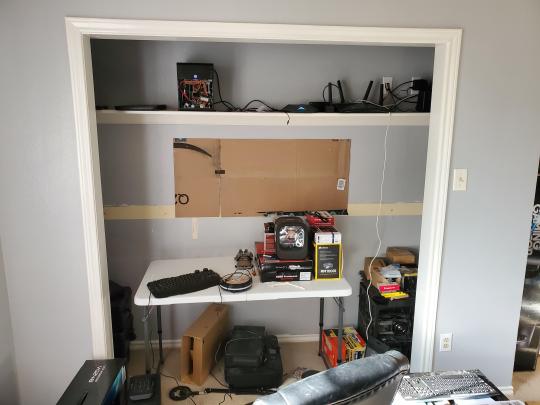
Moved into our first home almost a year ago (October 2019), I picked out a room that had 2 closets for my media/game/office area. Since the room isn't massive, I decided to build a desk into closet #1 to save on space. Here 1 of 2 shelves was ripped off, the back area was repainted gray. A piece of card board was hung to represent my 49 inch monitor and this setup also gave an idea how high I needed the desk.
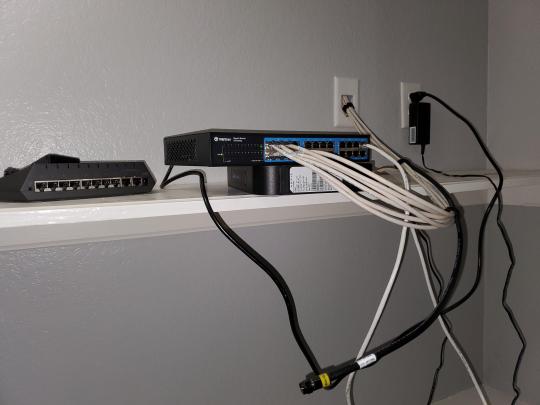
On my top shelf this was the initial drop for all my Cat6 cabling in the house, I did 5 more runs after this (WAN is dropped here as well).
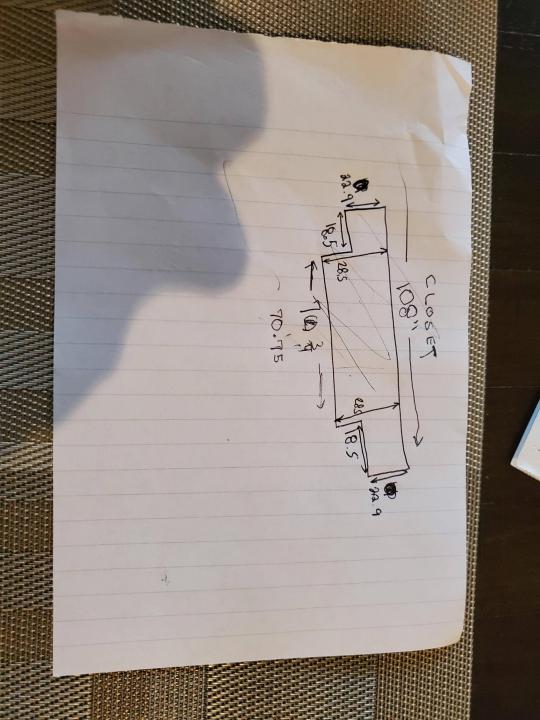
I measured the closet and then went to Home Depot to grab a countertop. Based on the dimensions, it needed to be cut into an object shape you would see on Tetris.

Getting to work, cutting the countertop.
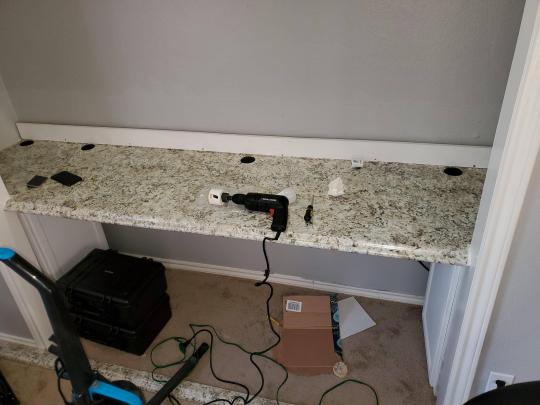
My father-in-law helped me cut it to size in the driveway and then we framed the closet, added in kitchen cabinets to the bottom (used for storage and to hide a UPS). We ran electrical sockets inside the closet. I bought and painted 2 kitchen cabinets which I use for storage under my desk as well.
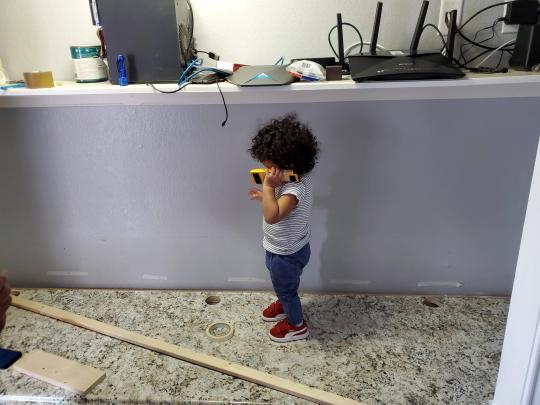
The holes allowed me to run cables under my desk much easier, I learned many of these techniques on Battlestations subreddit and Setup Wars on Youtube. My daughter was a good helper when it came to finding studs.
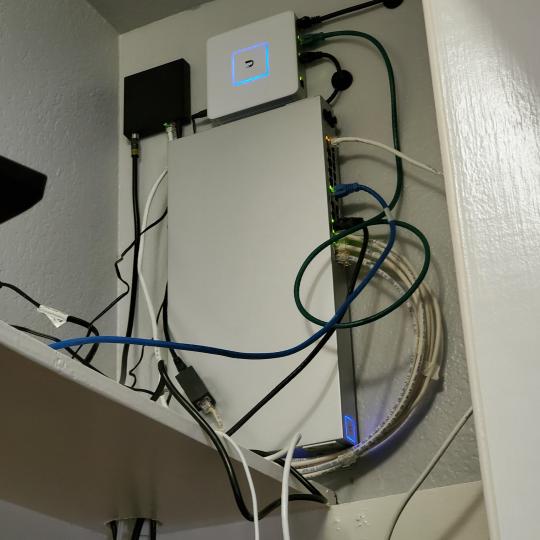
Some of my cousins are networking engineers, they advised me to go with Unifi devices. Here I mounted my Unifi 16 port switch, my Unifi Security Gateway (I'll try out pfSense sometime down the line), and my HD Homerun (big antenna is in the attic). I have Cat6 drops in each room in the house, so everything runs here. On my USG, I have both a LAN #2 and a LAN #1 line running to the 2nd closet in this room (server room). This shot is before the cable management.
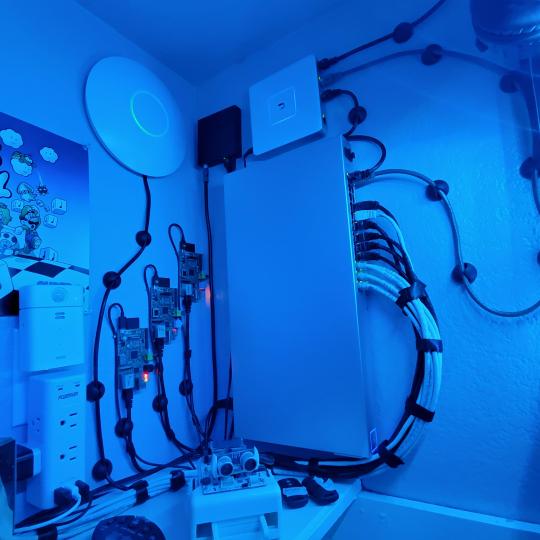
Cable management completed in closet #1. Added an access point and connected 3 old Raspberry Pi devices I had laying around (1 for PiHole - Adblocker, 1 for Unbound - Recursive DNS server, and 1 for Privoxy - Non Caching web proxy).
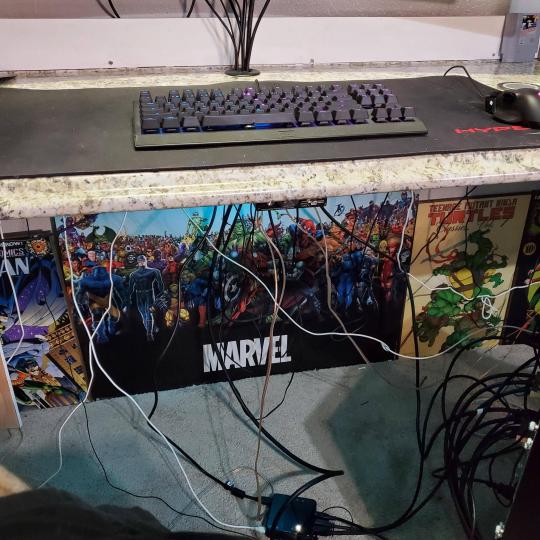
Rats nest of wires under my desk. I mounted an amplifier, optical DVD ROM drive, a USB hub that takes input from up to 4 computers (allows me to switch between servers in closet #2 with my USB mic, camera, keyboard, headset always functioning), and a small pull out drawer.
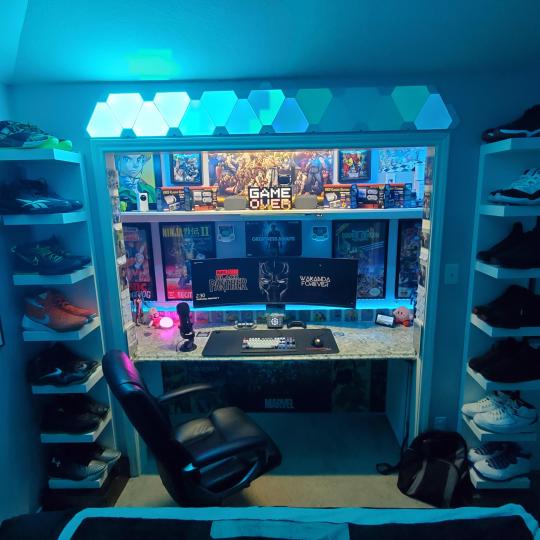
Cable management complete, night shot with with Nanoleaf wall lights. Unifi controller is mounted under the bookshelf, allows me to keep tabs on the network. I have a tablet on each side of the door frame (apps run on there that monitor my self hosted web services). I drilled a 3 inch hole on my desk to fit a grommet wireless phone charger. All my smart lights are either running on a schedule or turn on/off via an Alexa command. All of our smart devices across the house and outside, run on its on VLAN for segmentation purposes.

Quick shot with desk light off. I'm thinking in the future of doing a build that will mount to the wall (where "game over" is shown).

Wooting One keyboard with custom keycaps and Swiftpoint Z mouse, plus Stream Deck (I'm going to make a gaming comeback one day!).

Good wallpapers are hard to find with this resolution so pieced together my own.
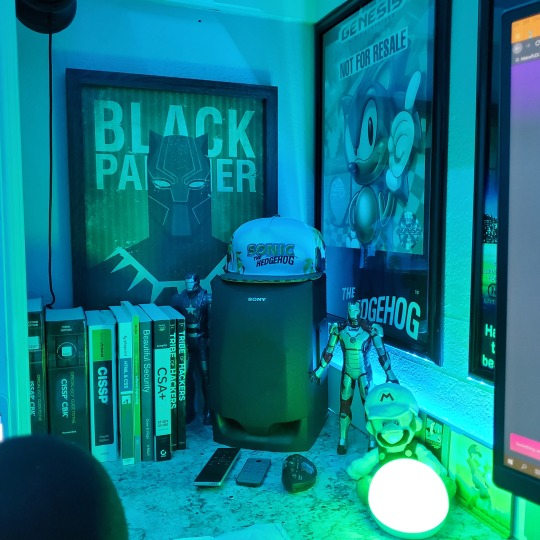
Speakers and books at inside corner of desk.

Speakers and books at inside corner of desk.
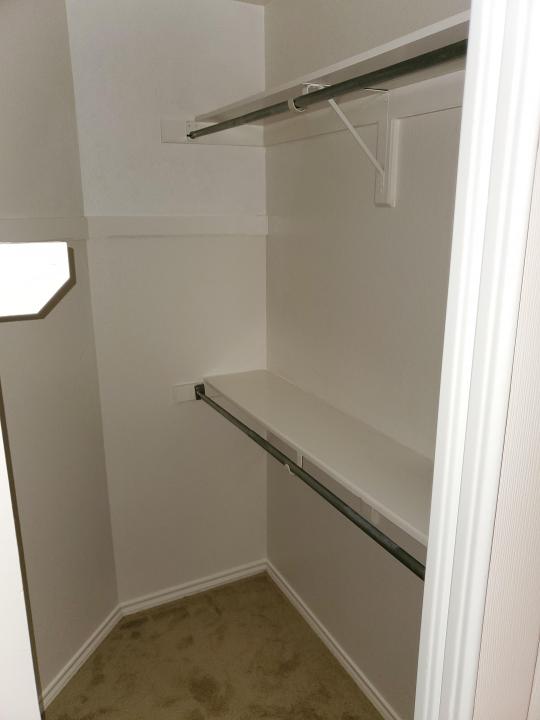
Closet #2, first look (this is in the same room but off to the other side). Ran a few CAT6 cables from closet #1, into the attic and dropped here (one on LAN #1, the other on LAN #2 for USG). Had to add electrical sockets as well.
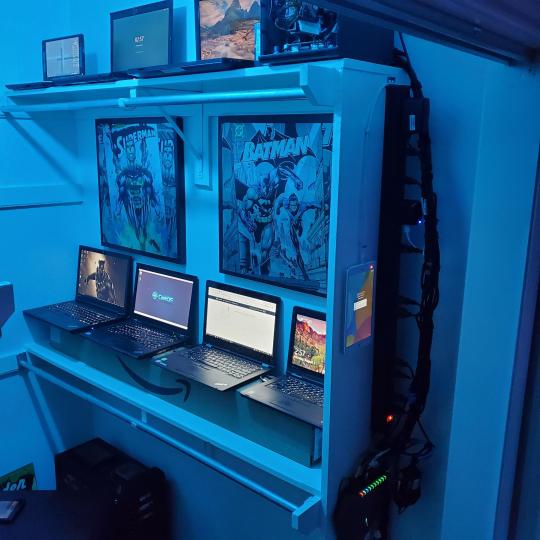
I have owned a ton of Thinkpads since my IBM days, I figured I could test hooking them all up and having them all specialize in different functions (yes, I have a Proxmox box but it's a decommissioned HP Microserver on the top shelf which is getting repurposed with TrueNAS_core). If you're wondering what OSes run on these laptops: Windows 10, Ubuntu, CentOS, AntiX. All of these units are hardwired into my managed Netgear 10gigabit switch (only my servers on the floor have 10 gigabit NICs useful to pass data between the two). Power strip is also mounted on the right side, next to another tablet used for monitoring. These laptop screens are usually turned off.
Computing inventory in image:
Lenovo Yoga Y500, Lenovo Thinkpad T420, Lenovo Thinkpad T430s, Lenovo Thinkpad Yoga 12, Lenovo Thinkpad Yoga 14, Lenovo Thinkpad W541 (used to self host my webservices), Lenovo S10-3T, and HP Microserver N54L
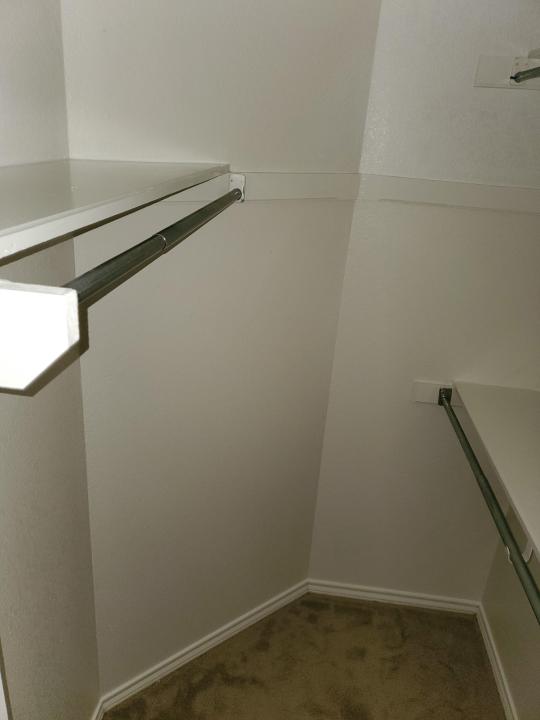
Left side of closet #2
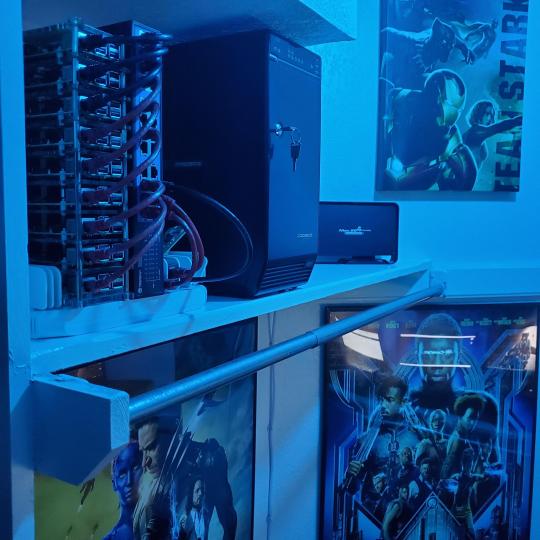
**moved these Pis and unmanaged switch to outside part of closet**
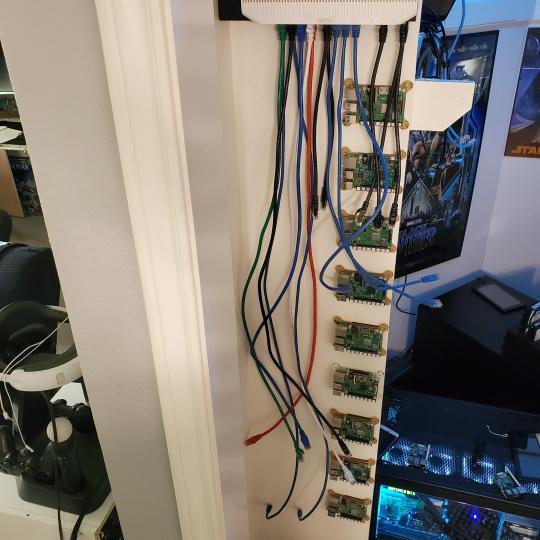
Since I have a bunch of Raspberry Pi 3s, I decided recently to get started with Kubernetes clusters (my time is limited but hoping to have everything going by the holidays 2020) via Rancher, headless. The next image will show the rest of the Pis but in total:
9x Raspberry Pi 3 and 2x Raspberry Pi 4
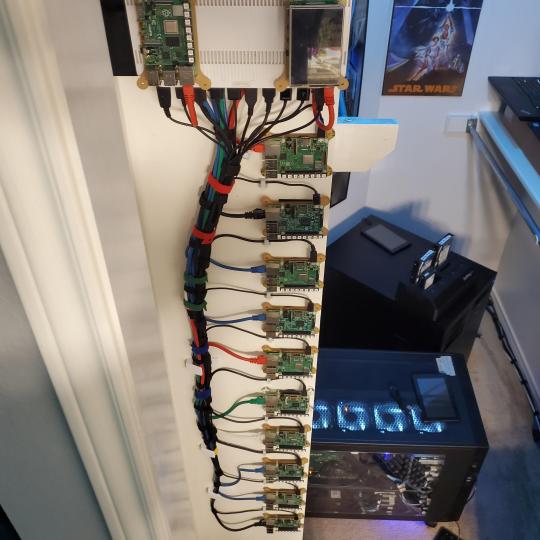
2nd shot with cable management. The idea is to get K3s going, there's Blinkt installed on each Pi, lights will indicate how many pods per node. The Pis are hardwired into a switch which is on LAN #2 (USG). I might also try out Docker Swarm simultaneously on my x86/x64 laptops. Here's my compose generic template (have to re-do the configs at a later data) but gives you an idea of the type of web services I am looking to run: https://gist.github.com/antoinesylvia/3af241cbfa1179ed7806d2cc1c67bd31
20 percent of my web services today run on Docker, the other 80 percent are native installs on Linux and or Windows. Looking to get that up to 90 percent by the summer of 2021.
Basic flow to call web services:
User <--> my.domain (Cloudflare 1st level) <--> (NGINX on-prem, using Auth_Request module with 2FA to unlock backend services) <--> App <--> DB.
If you ever need ideas for what apps to self-host: https://github.com/awesome-selfhosted/awesome-selfhosted
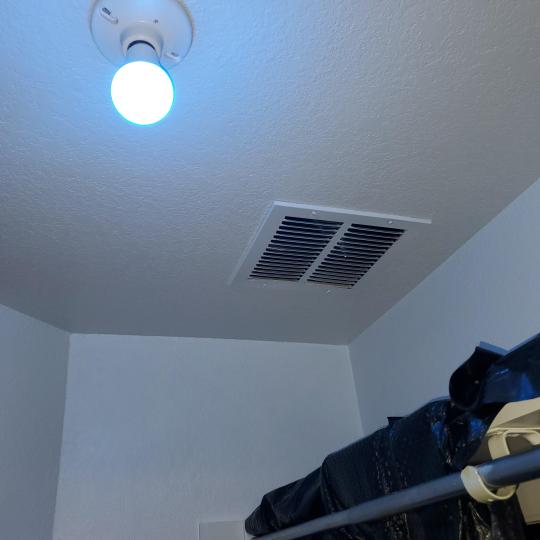
Homelabs get hot, so I had the HVAC folks to come out and install an exhaust in the ceiling and dampers in the attic.
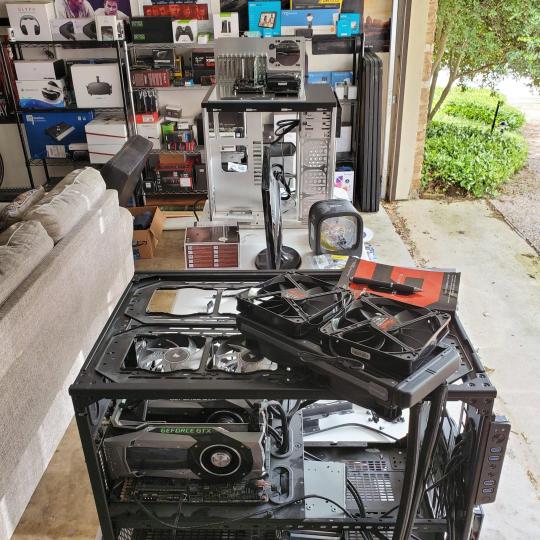
I built my servers in the garage this past winter/spring, a little each night when my daughter allowed me to. The SLI build is actually for Parsec (think of it as a self hosted Stadia but authentication servers are still controlled by a 3rd party), I had the GPUs for years and never really used them until now.
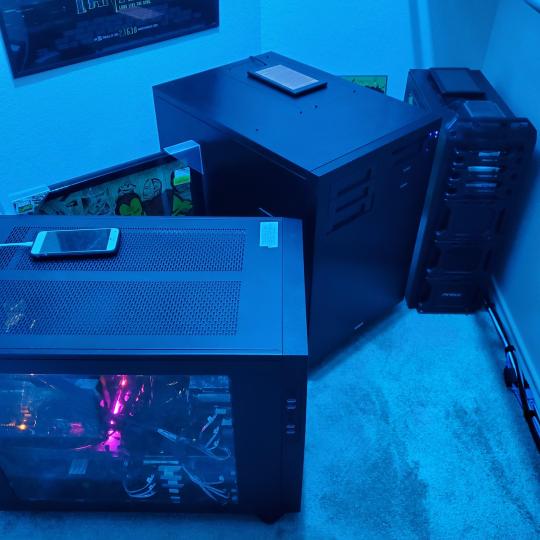
Completed image of my 2 recent builds and old build from 2011.
Retroplex (left machine) - Intel 6850 i7 (6 core, 12 thread), GTX 1080, and 96GB DDR4 RAM. Powers the gaming experience.
Metroplex (middle machine) - AMD Threadripper 1950x (16 core, 32 thread), p2000 GPU, 128GB DDR4 RAM.
HQ 2011 (right machine) - AMD Bulldozer 8150 (8 cores), generic GPU (just so it can boot), 32GB DDR3 RAM.
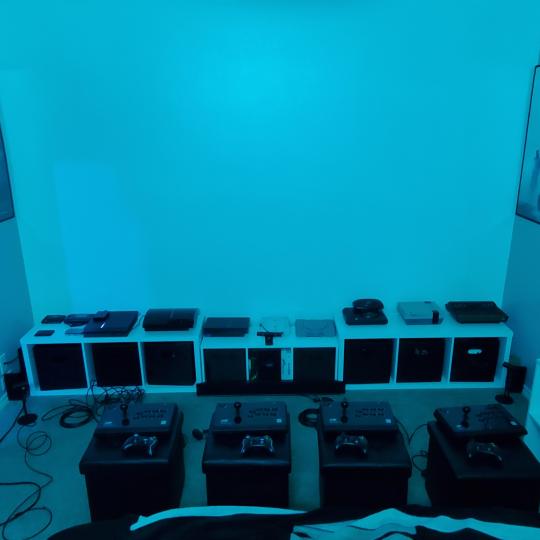
I've been working and labbing so much, I haven't even connected my projector or installed a TV since moving in here 11 months ago. I'm also looking to get some VR going, headset and sensors are connected to my gaming server in closet #2. Anyhow, you see all my PS4 and retro consoles I had growing up such as Atari 2600, NES, Sega Genesis/32X, PS1, Dreamcast, PS2, PS3 and Game Gear. The joysticks are for emulation projects, I use a Front End called AttractMode and script out my own themes (building out a digital history gaming museum).
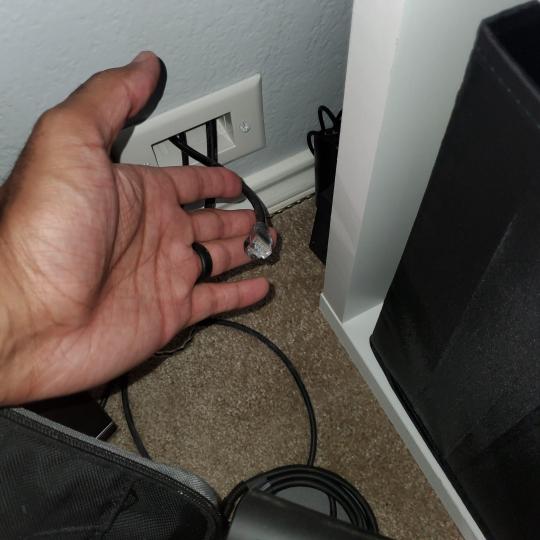
My longest CAT6 drop, from closet #1 to the opposite side of the room. Had to get in a very tight space in my attic to make this happen, I'm 6'8" for context. This allows me to connect this cord to my Unifi Flex Mini, so I can hardware my consoles (PS4, PS5 soon)

Homelab area includes a space for my daughter. She loves pressing power buttons on my servers on the floor, so I had to install decoy buttons and move the real buttons to the backside.
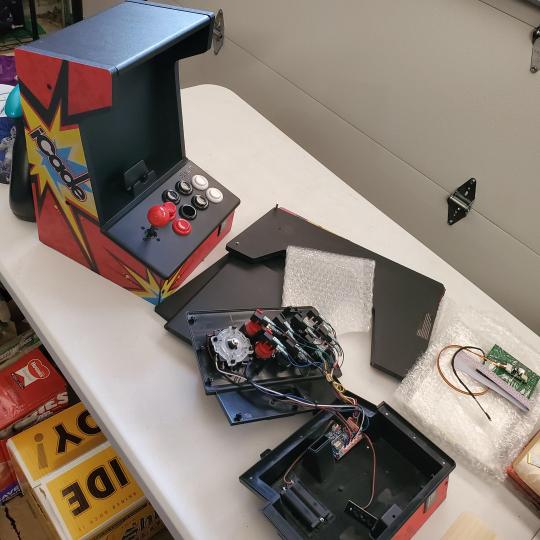
Next project, a bartop with a Raspberry Pi (Retropie project) which will be housed in an iCade shell, swapping out all the buttons. Always have tech projects going on. Small steps each day with limited time.
6 notes
·
View notes
Text
Subnautica
Eeeeee.
I mean, it's not like you can "fall" in this game. In the water, I mean. You can tread water over a yawning chasm forever (or until you die of suffocation, dehydration, or starvation). But just looking down into that deep darkness.
Such heebie-jeebies.
Which, of course, sent me off looking again. Now my seamoth has a defense system, solar and thermal chargers (just in case), and with mods for more slots plus arms, four storage bins, a hand arm, and a drill arm.
I despise how the PRAWN moves, absolutely hate it. So yeah, I upgraded the seamoth. I gave the prawn a whirl, just moving it from my near-the-escape-pod base to the right-on-the-edge-of-a-geyser base so I could park it in a moonbay (the other bay is for the seamoth, of course), and it was such a freakin' trial to get it over there.
And it was less than a thousand meters. Five hundred or more. A complete chore.
So I installed my newly fabricated additions and took her out for a glide. Drilled through a salt deposit, collected a bunch of scrap and non-drill deposits...
Took a minute to figure out how to choose which arm (the instructions were rather confusing, I must say, when taken with the comments section), but it was all good.
Needless to say, I backed up my save first to a separate location, in the event that the mods bricked my save or bugged it beyond repair.

I like it when the reefbacks wander by. I've gotten some good stuff off their backs.
Using the habitat platform thing, got verticals running down below sea level for the moonbays (and water filtrators), not that you can see them. There's a geyser at around -25m, right on the edge of a kelp forest, so it's nice, it's cozy, and I managed to shove four thermal generators down there.
Plenty of room for planting beds on the platform, and underwater beds, as well.
Did a run to Lifepod 2, which was uber scary (it's so deep!) and nabbed a bunch of blood oil and gel sacks, plus the second stasis rifle fragment (so I could finally make one).
Mind you, the arm won't help one bit with the situation I was in some hours earlier, while whacking eyestalks to get seeds. As I was doing so I was attacked by bleeders and got all turned around and really confused.
Running out of air, can't orient or figure out where my seamoth is... Gah. But I got to it in time, so I didn't suffocate.
What I can't remember is if I can run a vertical straight through the platform itself. I'll have to try.
And maybe at some point I'll meander off to the third Degassi base, and maybe to another Precursor site (cause I've only visited the Enforcement building).
And maybe at some point finally find the pieces I'm missing for the cyclops. And you know, the actual plot thing.
1 note
·
View note
Text
Electric car charger Pod Point issues profit warning on delayed home installations
Electric car charger Pod Point issues profit warning on delayed home installations
Electric car charging group Pod Point has issued a profit warning after long wait times for plug-in vehicles prompted car buyers to delay installing home chargers, its biggest source of revenue. Growth in sales of electric vehicles, or plug-in hybrids, has “slowed significantly” over the past year and a half, the EDF-backed group warned, sending shares down 6 per cent to 71.40p by late Monday…

View On WordPress
0 notes
Text
Pod point Charger Installation
Make the most of your Pod Point charger with Voltix's expert installation services. Our team of professionals will ensure your charger is installed correctly and efficiently, so you can start charging your electric vehicle with confidence.
0 notes
Text
A Comprehensive Review of the Pod Point Solo 3 EV Charger
As the transition to electric vehicles (EVs) continues to gather momentum, the demand for efficient and user-friendly charging solutions has never been higher. Among the various options available, the Pod Point Solo 3 EV Charger stands out as a popular choice for both homeowners and businesses. This comprehensive review will explore the features, installation process, usability, and overall performance of the Pod Point Solo 3 Charger, helping you determine if it is the right fit for your electric vehicle charging needs.

Overview of the Pod Point Solo 3 EV Charger
The Pod Point Solo 3 is a smart home EV charging station designed to provide efficient and flexible charging for electric vehicles. With a sleek design and advanced technology, it is tailored to meet the requirements of modern electric vehicle owners. This charger is capable of delivering up to 22 kW of power, making it suitable for a wide range of EV models.
Key Specifications
Charging Power: Up to 22 kW (3-phase charging)
Connector Type: Type 2
Smart Technology: Wi-Fi connectivity, smartphone app control
User Interface: LED indicators and simple controls
Weatherproof Rating: IP65, suitable for outdoor installation
Features of the Pod Point Solo 3 EV Charger
1. Smart Charging Capabilities
One of the standout features of the Pod Point Solo 3 is its smart charging capabilities. The charger connects to a dedicated smartphone app, allowing users to monitor their charging sessions in real-time. Through the app, users can schedule charging sessions, track energy consumption, and receive notifications when charging is complete. This level of control ensures that users can optimize their charging to take advantage of off-peak electricity rates, ultimately saving money on their energy bills.
2. Easy Installation
The installation process for the Pod Point Solo 3 is designed to be straightforward and efficient. The charger is compatible with both wall-mounted and pedestal installations, allowing users to choose the best setup for their space. Certified installers can handle the installation, ensuring that it meets all safety standards and regulations. Most installations can be completed in just a few hours, minimizing disruption to the homeowner’s schedule.
3. User-Friendly Design
The Pod Point Solo 3 features a user-friendly design that makes it easy for anyone to operate. The unit boasts a clear LED display that indicates charging status, and the Type 2 connector is designed for easy plug-and-play functionality. This intuitive design ensures that users can quickly start charging their vehicles without any complicated setup.
4. Compatibility with Multiple EV Models
The Pod Point Solo 3 is compatible with a wide array of electric vehicles, making it a versatile choice for households with more than one EV. Whether you own a compact electric car or a larger SUV, this charger can accommodate your charging needs with ease. Its flexibility makes it an ideal solution for families or shared residential spaces.
5. Robust Build Quality
Constructed with durability in mind, the Pod Point Solo 3 is designed to withstand the elements. With an IP65 weatherproof rating, this charger is suitable for outdoor installation, ensuring reliable performance in various weather conditions. Its robust build quality also means it can handle the rigors of daily use, providing peace of mind for users.
Usability and Performance
1. Charging Speed
The Pod Point Solo 3 is capable of delivering a maximum charging power of 22 kW when connected to a compatible three-phase power supply. This high power output allows EV owners to charge their vehicles quickly, making it an excellent choice for those with busy lifestyles. For users with a single-phase connection, the charger can still deliver 7.4 kW, which is sufficient for most home charging needs.
2. Scheduling and Energy Management
The smart technology integrated into the Pod Point Solo 3 allows users to schedule their charging sessions. This feature is particularly useful for those who want to take advantage of lower electricity rates during off-peak hours. By scheduling charging during these times, users can significantly reduce their energy costs while ensuring that their vehicles are fully charged and ready for use.
3. Remote Monitoring
The associated smartphone app provides users with the ability to monitor their charging sessions remotely. This capability allows users to check the status of their charging, review energy consumption data, and receive notifications when charging is complete. This level of oversight ensures that users can manage their charging habits effectively and make informed decisions about their energy usage.
Installation Process
1. Pre-Installation Assessment
Before installation, a qualified electrician will conduct a pre-installation assessment to determine the best location for the charger. This assessment includes evaluating the electrical supply, determining the most effective installation method (wall-mounted or pedestal), and ensuring compliance with local regulations.
2. Professional Installation
The installation of the Pod Point Solo 3 is typically performed by certified professionals who are familiar with EV charging systems. This expertise ensures that the installation is completed safely and efficiently, with minimal disruption to the homeowner. Once installed, the electrician will provide guidance on how to operate the charger and utilize its smart features.
3. Post-Installation Support
After installation, users can rely on the manufacturer's customer support for any questions or concerns. This support ensures that users can troubleshoot any issues that may arise and receive assistance with using the charger effectively.
Conclusion: Is the Pod Point Solo 3 Right for You?
The Pod Point Solo 3 EV Charger offers a comprehensive charging solution for electric vehicle owners seeking convenience, efficiency, and advanced technology. With its smart charging capabilities, user-friendly design, and robust build quality, it stands out as a reliable choice for both residential and commercial installations.
For those who prioritize quick charging times, the ability to schedule sessions, and the convenience of remote monitoring, the Pod Point Solo 3 is an excellent option. Its compatibility with multiple EV models makes it a versatile solution for families or individuals with diverse electric vehicle needs.
In summary, if you are considering an EV charger that combines performance, ease of use, and smart technology, the Pod Point Solo 3 is worth serious consideration. As the electric vehicle landscape continues to evolve, investing in a high-quality charger like the Pod Point Solo 3 can significantly enhance your driving experience and support the transition to a more sustainable future.
0 notes
Text
Electric Vehicle Charger Market Analysis by Size, Share, Growth, Trends up to 2032
By the end of the year 2033, the overall valuation of the global Electric Vehicle Charger Market Size is expected to be around US$ 68,967.2 million.
In response to the ongoing escalation in the cost of gasoline and diesel, there are greater sales of fuel-efficient automobiles like BEVs and HEVS. The depletion of fossil fuel sources and the rising propensity of businesses to maximize profit from these oil reserves are to blame for this. Therefore, these factors increase the need for cutting-edge EV charging technology, resulting in a rise in the popularity of electrically driven automobiles.
Electric Vehicle (EV) chargers, also known as Electric Vehicle Supply Equipment (EVSE), are devices that allow EVs to recharge their batteries. There are three main types of EV chargers: Level 1, Level 2, and DC fast chargers. Level 1 chargers use a standard household outlet and provide the slowest charging speeds, while Level 2 chargers provide faster charging speeds and require a 240-volt outlet. DC fast chargers provide the fastest charging speeds and are typically used for long-distance travel.
Furthermore, the market for EV chargers is expected to be driven by the growing demand for commercial and public charging stations. With the increase in EV adoption, there is a need for more charging infrastructure in public places such as parking garages, airports, and shopping centers. Additionally, businesses are also installing charging stations in their parking lots to cater to employees and customers who own EVs.
Key Takeaways
Germany holds an overall market share of 11.2% of the global EV charger business, which is higher than any other country. With the presence of some of the leading electric vehicle suppliers, it is poised to hold its dominance in the coming days.
The United States follows Germany in the production and sales of EV chargers, and contributes nearly 9.6% of the global revenue share. Significant expenditure by the key EV charger market players in research and development is poised to keep it a market leader in this sector.
In the Asia Pacific region, China is the leading manufacturer of chargers for electric vehicles and is poised to grow at 20.8% on an annual basis.
Meanwhile, India is anticipated to witness a year-on-year growth rate of 26.6% during the period from 2023 to 2033.
Based on vehicle type, battery-operated electric vehicles (BEVs) generate the most amount of demand for EV chargers around the world. In the year 2022, this market segment contributed revenue of around US$ 2,350 million, which was figured out to be 45.8% of the global EV charger market size.
Japan is also a prominent market, with substantial demand for EV chargers owing to the presence of many EV manufacturing companies. The overall value of the Japan EV charger market is expected to reach US$ 413.8 million by 2033.
For more information: https://www.futuremarketinsights.com/reports/ev-charger-market
Competitive Landscape
Key players operating in the global EV charger market are ABB Ltd., Robert Bosch GmbH, Siemens AG, Delphi Automotive, Chroma ATE, Aerovironment Inc., Silicon Laboratories, bp pulse, Schaffner Holding AG, and POD point among others.
Due to the existence of multiple market entities, the global EV charger industry is fairly fragmented and is getting more competitive each year. Also, for enhancing their market positions and expanding their shares, the leading players are consistently engaged in a variety of R&D initiatives. Other strategies include partnerships, buyouts, acquisitions, cooperation, new product introductions, and many others.
Recent Developments
BorgWarner Inc. finalized acquiring Delphi Technologies Company in the year 2020. The EV power electronics products, including the EV charger business of BorgWarner, are expected to benefit from the merger with Delphi Technologies.
According to an agreement between Enel X, Be Charge, and Eni Apps in December 2021, customers can utilize their smartphones to access charging stations.
0 notes
Text
Electric Vehicle Supply Equipment (EVSE) Market Opportunities, Top Manufactures, Industry Growth, Regional Analysis and Global Forecast to 2026

The Electric Vehicle Supply Equipment (EVSE) Market is expected to reach USD 19.99 Billion by 2026, according to a new report by Reports and Data. Electric Vehicle Supply Equipment is also known as an electric charging point or electric vehicle charging station. The chargers and the components that are built to create them are known as EVSE. They increase safety by facilitating two-way communication within the electric vehicle and the charging station. Electric buses and other large electric vehicles are growing in demand in this market, respectively. While electric buses are available commercially, larger heavy-duty vehicles are still under development.
Key Companies included in the report: Key participants include Bosch Automotive Service Solution Inc, Eaton, Liberty Plugins, Chargemaster PLC, ClipperCreek, NRG EVgo, ChargePoint, FullCharger, Elektromotive, Circontrol, Tesla Motors, ABB, Blink Charging, Schneider Electric, Siemens, General Electric, AeroVironment, IES Synergy, Chargemaster, DBT-CEV, Pod Point, BYD, Xuji Group, Potivio, Auto Electric Power Plant, Wanbang, and Qingdao Telaidia.
Get a sample of the report @ https://www.reportsanddata.com/sample-enquiry-form/1515
The market research report offers a comprehensive analysis of the competitive landscape through a study of company profile overview, product portfolios, manufacturing and production capacity, market share and size, global position, financial standing, technological developments, and production and manufacturing capacity of the prominent players. It also focuses on key M&A activities, joint ventures, collaborations, product launches and brand promotions, government deals and agreements, and partnerships among others undertaken by the top companies operating in the market. The report also covers a SWOT analysis and Porter’s Five Forces analysis of key players to provide deeper insights into the competition scenario.
The report further segments the market into major geographical regions of the world including North America, Europe, Asia-Pacific, Latin America, and Middle East & Africa. The regions and their respective major countries are analyzed with regards to their revenue contribution, production and consumption patterns, import/export, demand and supply ratio, and presence of key companies located in each region.
Further key findings from the report suggest
· Based on the End User, the market is segmented into residential, commercial, train stations and government buildings.
· The commercial end user segment is expected to witness the highest CAGR of 34.1% during the forecast period.
· The commercial segment is expected to adopt EVs as many actions like implementing fast charging points have been offered by the manufacturers to improve the existing EVs and to make the EVSE more suitable for long-distance travel.
· The Governments of Germany, USA, and Russia have also provided subsidies to execute the same.
· Growing technological advancement is assumed to drive the growth in the next few years.
· The cost of installing charging infrastructure and performance of vehicles is also expected to drive the growth during the forecast period.
Request a discount on the report @ https://www.reportsanddata.com/discount-enquiry-form/1515
Regional analysis covers:
· North America
o U.S.
o Canada
o Mexico
· Europe
o Germany
o U.K.
o Italy
o France
o BENELUX
o Rest of Europe
· Asia Pacific
o China
o India
o Japan
o South Korea
o Rest of APAC
· Latin America
o Brazil
o Rest of LATAM
· Middle East & Africa
o Saudi Arabia
o U.A.E.
o South Africa
o Rest of MEA
Further, the report segments the Electric Vehicle Supply Equipment market based on types and applications and offer insights into the key factors expected to influence revenue growth of the segment over the forecast period.
Level Outlook (Volume, Thousand Units; and Revenue, USD Million; 2016-2026)
· Level 1
· Level 2
· Level 3
End User Outlook (Volume, Thousand Units; and Revenue, USD Million; 2016-2026)
· Residential
· Commercial
· Train stations
· Government buildings
Equipment Type Outlook (Volume, Thousand Units; and Revenue, USD Million; 2016-2026)
· Portable Charger
· Fixed charger
Table of Contents-
Chapter 1. Market Synopsis
1.1. Market Definition
1.2. Research Scope & Premise
1.3. Methodology
1.4. Market Estimation Technique
Chapter 2. Executive Summary
2.1. Summary Snapshot, 2018-2026
Chapter 3. Indicative Metrics
Chapter 4. Electric Vehicle Supply Equipment Market Segmentation & Impact Analysis
4.1. Electric Vehicle Supply Equipment Market Material Segmentation Analysis
4.2. Industrial Outlook
4.2.1. Market indicators analysis
4.2.2. Market drivers analysis
4.2.2.1. Growing concern for environmental safety
4.2.2.2. Rising government initiatives
4.2.3. Market restraints analysis
4.2.3.1. Expensive maintenance cost
4.3. Technological Insights
4.4. Regulatory Framework
4.5. ETOP Analysis
4.6. Porter’s Five Forces Analysis
4.7. Competitive Metric Space Analysis
4.8. Price trend Analysis
Continued….
The report also offers strategic recommendations to the new players entering the market and gives them insights into how to tackle the entry level barriers. It also offers key insights to established players to fortify their presence in the market. The formulation of this report has been done through thorough primary and secondary research to offer a better understanding of the market size, market share, scope, challenges, trends, and growth prospects among the industry. The data has been further validated by industry experts, professionals, and research analysts.
Request a customization of the market @ https://www.reportsanddata.com/request-customization-form/1515
Thank you for reading our report. For further inquiry, please get in touch with us. Our team will ensure the report is customized to meet your requirements.
Have a Look at Related Reports:
Automotive Cyber Security Market Share
CMP Pad Conditioners Market Size
#Electric Vehicle Supply Equipment (EVSE) Market#Electric Vehicle Supply Equipment (EVSE) Market share
0 notes
Link
A home car charger is a compact weatherproof unit that amounts to a wall with a connected charging cable or a socket for plugging in a portable charging cable. Dedicated home charging points are installed by qualified specialist installers like Pod Point.
0 notes
Text
What future holds for EV Charging Connectors Market?
Global EV Charging Connectors Market is valued at USD 39.8 Million in 2020 and expected to reach USD 127.6 Million by 2027 with a CAGR of 18.1% over the forecast period.
EV Charging Connectors Market: Global Size, Trends, Competitive, Historical & Forecast Analysis, 2021-2027- Increasing demand for electric vehicles due to environmental regulations is one of the major factors anticipated to drive the growth of Global EV Charging Connectors Market.
We Have Recent Updates of EV Charging Connectors Market and Get Premium Sample Copy@ https://brandessenceresearch.com/requestSample/PostId/1448?utm_source=BSN&utm_medium=AR
During Covid-19 Pandemic, the consumer’s purchasing power has been reduced. The social distancing & reduced EV sales in lockdown resulted in negative effect on the EV charging connectors market. The situation of EV market after lockdown is reaching to pre-covid-19 level and expected to grow in coming few years.
News: EV Charging Groups are Focusing on the UK’s Ban on Sales of Diesel & Petrol Car by 2030.
On January 18th, 2021; The UK government is focusing to ban the sale of petrol and diesel car by 2030 which has led the increased demand of EV. 1 in 10 car in 2020 with 6.6% battery electric car and 4.1% hybrid car plug in to charge. The infrastructure demand has increased & companies like Ecotricity, Ubitricity and Pod Point rolling out public charger. Greater London has max 9400 connectors in comparison to 500 in Northern Ireland. The requirement for long distance drivers rapid charging and to individual who can’t pay for connector installed at home and don’t have off street parking.
Scope of Global EV Charging Connectors Market Report:
EV Charging Connectors are the connecting socket which is used to charge the electric vehicle at the charging station. Its function is similar to that phone charger but it is designed to conduct high power. The connector can be found in different shape & sizes depend on the charging facility or type i.e. fast/slow or power carrying capacity i.e. 7kW/22Kw etc. It is used to charge electric vehicle i.e. car, bike, etc in an efficient, fast and reliable way. The charging connectors are different based on region, depending upon the manufacturer or regional manufacturing standards i.e. European standard, American standard, Tesla connector and etc.
The manufacturing of connector requires maintaining high product quality for the safety of users, EV and infrastructure. The EV manufacturer like Tesla, BMW, Audi has been leading the way for market to pot of electric vehicle. There are several types of connectors based on technological changes done in the past. There are many economies which are trying to shift to 100% electrical vehicle in some year like Britain.
Key Players for Global EV Charging Connectors Market Report:
Some of the key players for global EV charging connector market are Schneider Electric, Yazaki, Bosch, Tesla, Siemens AG, ABB, Amphenol, Fujikura, Sumitomo, AeroVironment, Inc., BP Chargemaster, ChargePoint, ClipperCreek, Eaton Corp., General Electric Company, Leviton Manufacturing Co., SemaConnect, Inc., Webasto SE and others.
To Read More about the Study, Read the Complete Description @ https://brandessenceresearch.com/automotive-and-transport/ev-charging-connectors-market-size
Increasing Demand for Electric Vehicles due to Environmental Regulations is One of the Major Factors Anticipated to Drive the Market Growth
The increasing demand of EVs is one of the major factors driving the growth of global EV charging connectors market. The exhaust gases of car contain carbon monoxide, sulfur dioxide, nitrogen oxides, etc which are harmful and results in health issues, global warming and etc. EV reduces the exhaust gases to minimal level. In addition, the over dependence on fossil fuel for petroleum, coal, etc. results in depletion & extinction of natural resources. In addition, supportive government policies to encourage the adoption of EVs are also supplementing the market growth.
Key Benefits for Global EV Charging Connectors Market Report:
Global EV Charging Connectors Market report covers in-depth historical and forecast analysis.
Global EV Charging Connectors Market research report provides detail information about Market Introduction, Market Summary, Global market Revenue (Revenue USD), Market Drivers, Market Restraints, Market Opportunities, Competitive Analysis, Regional and Country Level.
Global EV Charging Connectors Market report helps to identify opportunities in marketplace.
Global EV Charging Connectors Market report covers extensive analysis of emerging trends and competitive landscape.
Global EV Charging Connectors Market Segmentation:
By Level of charging:
Level 1
Level 2
Level 3
Level 4
By Voltage Type:
Ac charging
Dc charging
By Charging speed:
Slow
Fast
Rapid
Ultra rapid
By Component:
Leads
Adapters
Wallbox
Portable Chargers
Pins
Delta AC Mini Plus
By Application:
Residential
Commercial
Request for Methodology of this report: https://brandessenceresearch.com/requestMethodology/PostId/1448?utm_source=BSN&utm_medium=AR
EV Charging Connectors Market By Regional & Country Level:
North America
U.S.
Canada
Europe
U.K.
France
Germany
Italy
Asia Pacific
China
Japan
India
Southeast Asia
Latin America
Brazil
Mexico
Middle East and Africa
GCC
Africa
Rest of Middle East and Africa
Asia Pacific is anticipated to capture the Significant Share in the Global EV Charging Connectors Market.
The global EV charging connectors market is segmented into North America, Europe, Asia-Pacific Latin America and Middle East & Africa. The Asia Pacific is expected to grow at a fast pace due to its large population & some technically advanced economies like China which has highest EV in world. The region has developing infrastructure & hence leads significant opportunity to grow.
About: Brandessence Market Research Inc.
Brandessence market research publishes market research reports & business insights produced by highly qualified and experienced industry analysts. Brand Essence Market Research report will be best fit for senior executives, business development managers, marketing managers, consultants, CEOs, CIOs, COOs, and Directors, governments, agencies, organizations and Ph.D. Students. We have a delivery center in Pune, India and our sales office is in London.
Contact Us:
Alan Ruffalo
Corporate Sales: +44-2038074155
Email: [email protected]
Web: https://brandessenceresearch.com/
0 notes